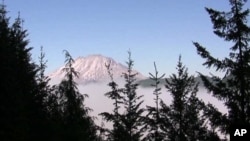On May 18, 1980, Mount St. Helen's, a volcano in the U.S. northwestern state of Washington, erupted. The eruption destroyed everything in its path. Thirty years later, the land around the volcano is still recovering from the eruption's effects.
It was originally nicknamed "Louwala-Clough," or "smoking mountain" by a local Indian tribe. Mt. St. Helen's lived up to its Indian name on a bright spring day in 1980, when it erupted - leveling entire forests and blackening the skies for hundreds of kilometers with volcanic ash.
The eruption, though sudden, was not unexpected.
"On May 18th, we had been monitoring the volcano for almost two months," said Professor Stephen Malone of the University of Washington. "There had been very strong seismic activity, minor explosive activity, as well as some deformation, where the ground was actually moving."
A magnitude 5.1 earthquake earlier in the day may have triggered the most destructive landslide and volcanic eruption in U.S. history. Unlike most volcanic eruptions, the lava and magma did not shoot straight up, but laterally.
"We think the lateral blast in this case, was due to the asymmetry of the magma [molten rock] coming into the volcano," said Professor Malone. "Rather than coming straight up the middle [of the volcano], it had a sideways motion, that caused part of the volcano to deform unusually."
When the deformation, or bulge, on the volcano's northern slope collapsed, the sudden release of pressure caused the lateral blast.
The massive landslide and eruptions leveled 500 square kilometers of forest, and killed 57 people. It also killed almost all the plant and animal life in the blast zone - the area hit hardest by the volcanic blast.
Almost ... but not all.
"The eruption happened in mid-May, at a time when the high mountain environment was under snow in many places. … also the plants throughout the area were in a wintertime condition, and died back to their roots," said Mt. St. Helen's Monument Scientist Peter Frenzen. "So underneath the 1980 ash and blast deposits, there were many living plant roots and burrowing animals that managed to survive in protected pockets throughout the blast zone."
Eruptions at Mt. St. Helens continued, though none were as destructive as the 1980 blast.
During this period of relative calm, the few animals and plants that survived in the blast zone were able to grow and thrive. In the years that followed, other wildlife returned.
But Professor Malone says another eruption is inevitable.
"It may be many decades to centuries before Mt. St. Helens does another really major explosive eruption," he said. "But sooner or later, it will, it's a very active volcano."
Two years after the eruption, Congress set aside about 45,000 hectares around the mountain as the Mt. St. Helens National Volcanic Monument, for research, recreation and education. As the land is left to heal without human interference, it has become a living laboratory in which scientists and the public can observe the amazing return of life to the area - in the shadow of a volcano that will likely erupt again.







